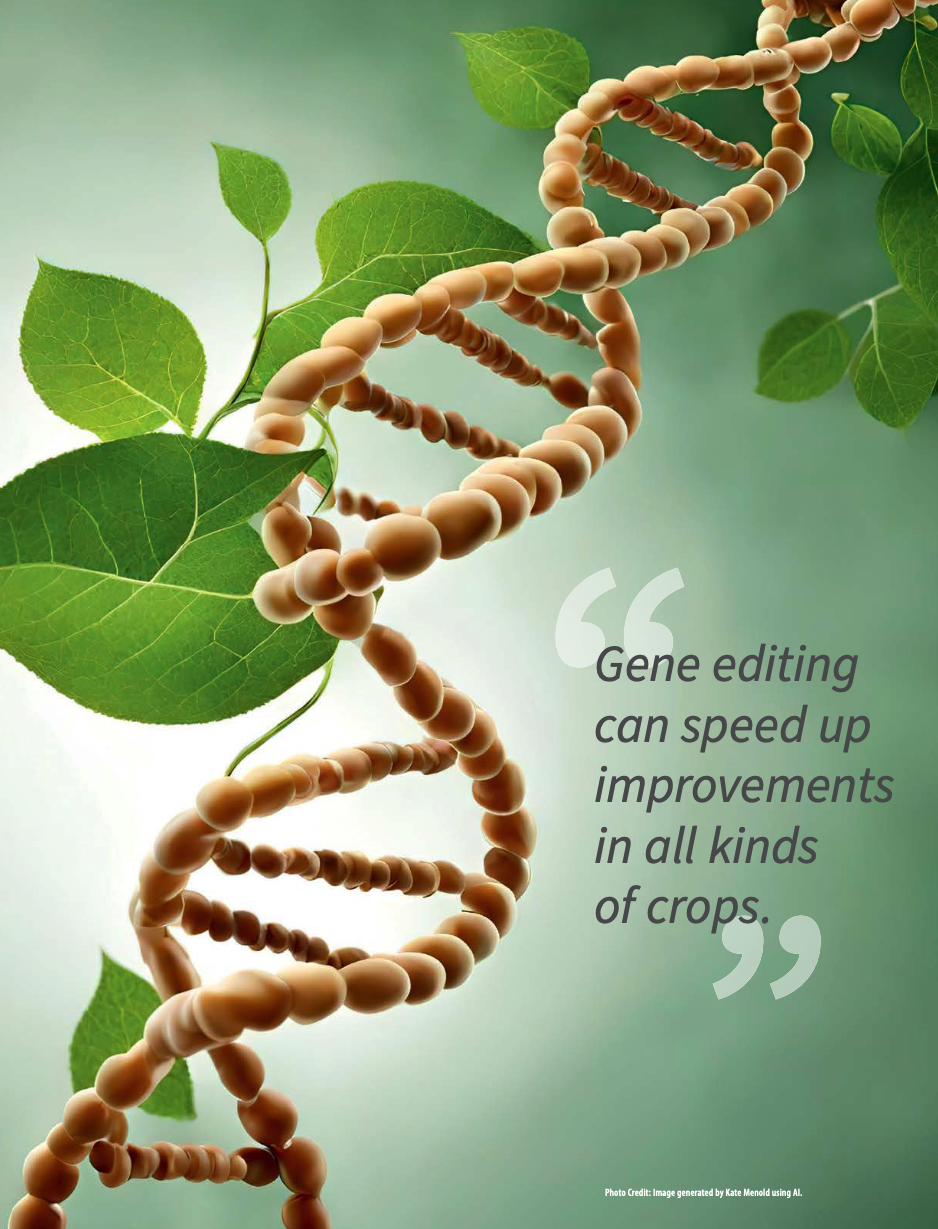 The transformative impact for Manitoba’s pulse and soybean Farmers
The transformative impact for Manitoba’s pulse and soybean Farmers
Toban Dyck, writer and farmer
THIS YEAR, THE Canadian Food Inspection Agency (CFIA) released updated guidance regarding gene-edited crops. The new guidance arrived to a happy, albeit impatient, audience that anticipated its contents and was biting its tongue waiting for Canada to green light a regulatory morsel that has already been approved in much of the world.
According to the Canada Grains Council’s website, “Gene editing is a relatively new method plant breeders can use to make precise, targeted changes to a plant’s DNA. This process mirrors what can happen in nature or through traditional plant breeding, but in a more efficient way.”
Until this guidance came out, breeders involved in gene editing were subject to the same rigorous protocols and regulatory roadblocks as those involved in creating genetically modified organisms (GMOs), resulting in exponential cost increases and lengthy market-readiness timelines. Gene- edited crops are still subject to regulatory oversight, but it’s more aligned with other non-GMO processes.
“Gene editing is a game changer for plant breeders, no matter which crop they are working on,” says Krista Thomas, vice president of trade policy and seed innovation at the Canada Grains Council, emphasizing the role of gene editing in expediting the breeding process and yielding crops with enhanced disease resistance and stress tolerance, higher yields, and improved agronomic performance. This revolutionary technique mirrors natural processes and traditional plant breeding but does so with unprecedented efficiency.
“Take certain pulse crops, for example, where breeders often want to reduce antinutrients. Gene editing can make this process quicker and more precise,” she says. This targeted approach not only expedites the development of crops with desired traits but also enhances precision, ensuring a more predictable and reliable outcome.
Pulse crops, in contrast to corn, soy, and canola, have not been subject to GMO- type modification. Because of this, there is concern that they could be losing ground to other crops in their productivity and market attributes. Gene editing provides a way for pulses to preserve their non-GMO status while accomplishing critical steps in genetic improvement in a faster, more efficient manner.
In May of this year, China granted its first approval of a gene-edited soybean variety, a move made, in part, as it increasingly leans on science to increase its food production. The soybean in question has two modified genes that raise the plant’s level of oleic acid, a healthy fat. Another case comes from Brazil, where Embrapa Soybeans used Clustered Regularly Interspaced Short Palindromic Repeats (CRISPR) technology to deactivate lectin, an antinutritional factor, in soybean DNA.
In September, Canadian researchers used gene editing to improve the aroma, fatty acid, and flavour profiles in yellow peas – also a first-of-its-kind breakthrough.
Thomas clarifies that plants developed through targeted editing of their own DNA are not GMOs. “They are indistinguishable from traditionally bred plants,” she says. This clarification becomes paramount as the term “GMO” typically refers to plants containing foreign DNA from a different species.
“Gene editing can speed up improvements in all kinds of crops,” she notes. This is a crucial advantage, considering that traditional biotech methods often face challenges due to the slow and expensive nature of navigating complex global GMO regulations. In contrast, gene editing presents a more straightforward path to market in most countries, promising a quicker and more cost-effective route for introducing innovations.
The economic impact of gene editing extends beyond its benefits for regulatory efficiency. Thomas emphasizes that the technology not only addresses challenges in developing transgenic varieties but also benefits conventional breeding in Canada. She also notes the positive impact on research funding and the overall attractiveness of Canada as a breeding ground for innovation. This is especially timely, as many companies and researchers have been moving their funding and expertise to countries with innovation- friendly regulatory environments.
In the context of regulatory advancements, Thomas highlights the significant progress made globally regarding the treatment of gene-edited plants. “Compared to five years ago, we have much better regulatory clarity about how plants developed using gene editing are going to be treated,” she says. The international consensus recognizes gene-edited plants as distinct from GMOs, paving the way for a more efficient regulatory process.
Manitoba Pulse & Soybean Growers’ sister groups – Pulse Canada and Grain Growers of Canada – have been supporters of Canada Grains Council’s efforts to facilitate regulatory advancements in Canada, such as the transformative potential of gene editing. However, although gene editing offers great precision, researchers still need to know what genes to look for. This research takes a lot of time. As a result, continued investment in research to identify gene targets is required. Farmers in the province can anticipate a future characterized by faster, more accurate breeding processes, enhanced crop traits, and sustained innovation.

